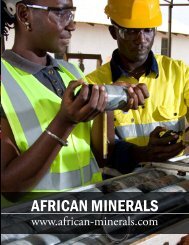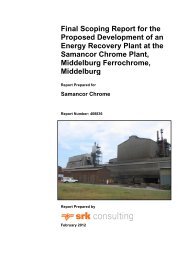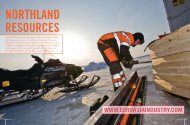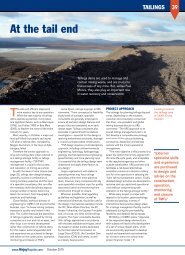Draft Status Quo Report for the Pixley Ka Seme ... - SRK Consulting
Draft Status Quo Report for the Pixley Ka Seme ... - SRK Consulting
Draft Status Quo Report for the Pixley Ka Seme ... - SRK Consulting
Create successful ePaper yourself
Turn your PDF publications into a flip-book with our unique Google optimized e-Paper software.
<strong>SRK</strong> <strong>Consulting</strong> in association with BKS<br />
<strong>Pixley</strong> <strong>Ka</strong> <strong>Seme</strong> Local Municipality EMF – <strong>Draft</strong> <strong>Status</strong> <strong>Quo</strong> <strong>Report</strong> Page 46<br />
The people that inhabited <strong>the</strong> sou<strong>the</strong>rn parts of<br />
Mpumalanga be<strong>for</strong>e <strong>the</strong> 19 th century were <strong>the</strong> Bakgatla,<br />
Barolong, Bantwane, Bakone, Bakopa and Sou<strong>the</strong>rn<br />
Ndebele communities (Makhura, 2006). The Eastern-<br />
Sotho, in this case consisting of <strong>the</strong> BaPai, inhabited an<br />
area close to modern day Swaziland during <strong>the</strong> 17 th<br />
century (Makhura, 2006).<br />
Historic period<br />
Due to factors such as population growth and a decrease<br />
in mortality rates, <strong>the</strong>re have been more inhabitants<br />
during <strong>the</strong> recent historical past, and far more cultural<br />
heritage resources from this era remain on <strong>the</strong><br />
landscape.<br />
None of <strong>the</strong> early trade routes in <strong>the</strong> interior of South<br />
Africa are known to have traversed <strong>the</strong> area of study<br />
(Bergh, 1999), although it is possible that secondary<br />
routes did pass through <strong>the</strong> south-east of Mpumalanga.<br />
It was <strong>the</strong>re<strong>for</strong>e mainly <strong>the</strong> Swazi who inhabited <strong>the</strong><br />
PKSLM area <strong>the</strong> beginning of <strong>the</strong> 19 th century<br />
(Makhura, 2006; and Mitchell, 2006). In 1800<br />
Dingiswayo fled to Hlubi close to Wakkerstroom. He<br />
died in 1818 and his empire was taken over and<br />
streng<strong>the</strong>ned by Shaka (Hofmeyr and Smith, 2009).<br />
During <strong>the</strong> Difaquane (1820-1837) <strong>the</strong> Ndebele of<br />
Mzilikazi moved through this landscape and some even<br />
settled here. The Phuthing fled to <strong>the</strong> south, while <strong>the</strong><br />
Swazi moved to <strong>the</strong> north and west, <strong>the</strong>re<strong>for</strong>e inhabiting<br />
<strong>the</strong> area (Bergh, 1999; and Bergh and Bergh, 1984).<br />
Remains of settlements of all three of <strong>the</strong>se groups<br />
should be expected, although <strong>the</strong> Ndebele usually didn’t<br />
develop <strong>the</strong>ir own settlements but reused those of <strong>the</strong><br />
people <strong>the</strong>y conquered.<br />
White farmers only moved into south-eastern<br />
Mpumalanga after 1853 when <strong>the</strong> government of <strong>the</strong><br />
South African Republic traded land from <strong>the</strong> Swazi.<br />
Wakkerstroom became a town and district shortly<br />
<strong>the</strong>reafter (Bergh, 1999). The town mainly served as<br />
market <strong>for</strong> local farmers (Hofmeyr and Smith, 2009).<br />
Volksrust was established in 1889 and Amersfoort in<br />
1890.<br />
Missionaries also came to this part of <strong>the</strong> country<br />
during <strong>the</strong> 19 th century. The Dutch Re<strong>for</strong>med Church<br />
and <strong>the</strong> Hermannsburg Missionaries established mission<br />
stations at Volksrust and Wakkerstroom during this<br />
time (Bergh, 1999).<br />
During <strong>the</strong> Anglo-Transvaal War (1880-1881) <strong>the</strong><br />
PKSLM area was <strong>the</strong> focus point of battles between <strong>the</strong><br />
British and <strong>the</strong> Boers. The British had a camp in<br />
Wakkerstroom and were beleaguered by <strong>the</strong> Boers.<br />
Important battles fought during 1881 were at<br />
Laingsnek, Schuinshoogte and Amajuba in <strong>the</strong><br />
Volksrust vicinity. Wakkerstroom cemetery has a<br />
commemorative stone <strong>for</strong> some of <strong>the</strong> British soldiers<br />
who died during this war as well as <strong>the</strong> Anglo-Boer<br />
War.<br />
The PKSLM also experienced action during <strong>the</strong> Anglo-<br />
Boer War (1899-1902). During <strong>the</strong> British offensive in<br />
1900, Volksrust and Amersfoort were occupied. A<br />
battle occurred to <strong>the</strong> north of Volksrust as well as a<br />
skirmish at <strong>Ka</strong>strolsnek near Wakkerstroom (Hofmeyr<br />
and Smith, 2009). During this war, a concentration<br />
camp <strong>for</strong> <strong>the</strong> Boer woman and children was established<br />
in Volksrust by <strong>the</strong> British (Bergh, 1999). Monuments<br />
were erected at <strong>the</strong> town hall commemorating <strong>the</strong><br />
women, children and soldiers who died during <strong>the</strong><br />
Anglo-Boer War.<br />
3.6 Resource economics<br />
The Resource Economics specialist report (Van Zyl,<br />
2010) presents <strong>the</strong> key issues and findings related to<br />
this topic <strong>for</strong> PKSLM. Resource economics focuses on<br />
<strong>the</strong> use of environmental resources and trade-offs<br />
arising between different resource uses. It generally<br />
attempts to quantify uses and trade-offs in monetary<br />
terms as far as is possible and sensible. With regard to<br />
<strong>the</strong> existing state of <strong>the</strong> environment, resource<br />
economics commonly disaggregates <strong>the</strong> Total<br />
Economic Value (TEV) of a given environment into<br />
different types of values in order to better understand<br />
how <strong>the</strong> environment creates values and contributes to<br />
economic development (see Figure 3-5).<br />
KILI/BEAT G:\404946_PIXLEY EMF\7REPORTS\<strong>Status</strong> <strong>Quo</strong> report\<strong>Draft</strong> report\<strong>Draft</strong> status quo report, July 2010.docx July 2010









